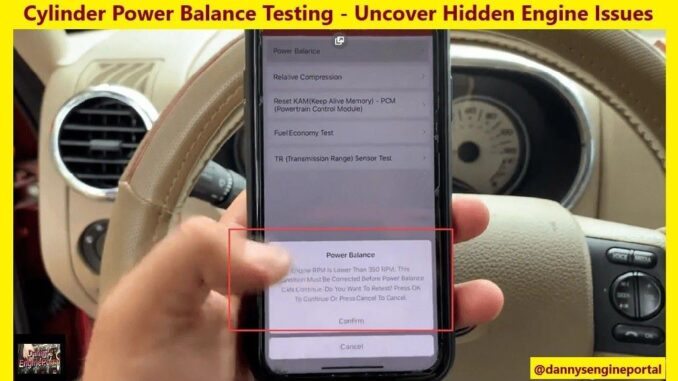
So, performing a cylinder power balance test can help uncover hidden engine problems; which are commonly missed with other tests.
This test can find problems related to engine misfires, lack of power, or just a poor running engine.
And, is often used along with a compression and cylinder leak down test to further pinpoint the problem.
Doing a cylinder power balance test, is one of the best and easiest ways, to find the source of problems.
Engine Misfires
Engine misfires can be fairly random and if spaced far enough apart, they should not cause any harm. But, a frequent or steady misfire will cause a sharp rise, in unburned hydrocarbon emissions.
As a result, you could see a noticeable drop in power. And, a significant decrease in fuel economy. Cylinder power balance testing involves disabling one cylinder at a time, then recording the (RPM).
Actually, you can perform a cylinder power balance test in several different ways. So, knowing each of the options will allow you to choose the easiest one, for the vehicle you are diagnosing.
Some Of These Options Depend On:
- The capabilities of the (PCM).
- The ease of accessing the required components.
- And, the tools you have available for the job.
In some cases, you can use a scan tool to do the work. This means it can tell the (PCM) to perform an automatic cylinder power balance test. Then it reports the results directly on the scan tool. So, on most newer vehicles, using the scan tool is by far the best method. This makes performing a cylinder power balance test a lot easier.
But, if the system is not setup to perform the test automatically, you will have to do it manually.
You will need to decide whether to disable the ignition or the fuel to each individual cylinder.
So, if the engine has port fuel injectors that are accessible. Then, disconnecting the electrical connector from each fuel injector one at a time will shut off the fuel. And, if only the ignition system is disabled, then the fuel will still be delivered. But, it will not be burned in the cylinder.
Then, this may cause it to burn in the catalytic converter which can cause it to overheat and be damaged. Therefore, shutting down the fuel is preferable, if it is an option.
Cylinder Power Balance Testing Can Be Done Many Ways
(COP) Ignition
If the engine has individual ignition coils on each spark plug. Then, you can disconnect the primary electrical connector, which will shut off the spark to the spark plug.
Waste Spark System
If the vehicle has coils that share cylinders. Then, you can place a 1″ (25-mm) section of vacuum hose, between each coil tower and spark plug wire. Then, connect an alligator clip from a non powered test light, to a good engine ground. Next, touch the tip of the test light to each length of vacuum hose to short out each spark plug.
Distributor Ignition
If the vehicle has a distributor, disconnect one spark plug at a time from the distributor cap. Also, it’s a good idea to use a test lead to ground the spark at the distributor cap terminal. Because, doing this will help prevent the spark from damaging the ignition module. And, it shuts down the spark for the cylinder being tested.
How To Do A Cylinder Power Balance Test
First, visually inspect the engine to determine the best method to disable the cylinders. For example, this may include connecting a scan tool; installing vacuum lines on each coil or removing spark plug wires. If necessary, disable the (IAC) system.
Now, Start Testing:
- Start the engine and allow it to idle.
- Now you will need to record the (RPM).
- Using the method chosen to disable cylinders. Disable the first cylinder and record the (RPM).
- Now, Reactivate the cylinder and allow the engine to run for approximately 10 seconds to stabilize.
- Repeat the steps on each of the cylinders and record your readings.
- Now, Use the results to determine any necessary repairs.
In Summary: Cylinder Power Balance
- Compression testing determines the maximum pressure in the cylinder, on the compression stroke of the piston.
- Cylinder leak down testing measures how well the cylinder is sealed.
- The cylinder power balance test compares the contribution of each cylinder, to the total power of the engine.
Finally, by comparing the results of each one of these tests to each other; you can identify any problems.
Thank You!




